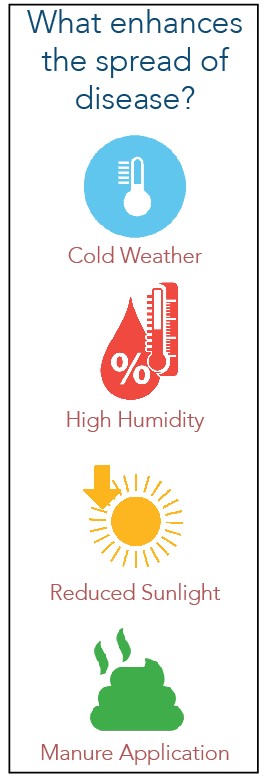
PRRS, the 4-letter abbreviation that should make any hog producer shutter. The extensive disease pressure this year has likely caused this feeling more than once. Porcine Reproductive and Respiratory Syndrome (PRRS) is a viral disease resulting in complications with reproduction and respiratory disease in pigs of any age. Since last fall, there has been an increase in PRRS activity across, Minnesota, Iowa, South Dakota, and Nebraska.
Additionally, PRRS activity amongst sow herds create many PRRS positive pigs weaned into nurseries or wean-to-finish barns over the course of 6+ months. While disease prevention is the overall goal, this may be difficult to achieve in hog dense areas. A tool that can be used to mitigate production impacts, mortality, and decrease transmission is PRRS vaccination. 
Impact of PRRS:
There is no doubt that a PRRS challenge can be costly at any phase in the grow-finish period. Losses from PRRS due to increased mortality, reduced average daily gain (ADG), reduced feed conversation (F/G), and other factors can be significant.
A 2013 study found:
Cost of PRRS in the United States = $664 million with $361.85 million accounted for in the grow-finish phase.
$4.32 per pig
Why Vaccinate?
If you own pigs in a pig dense area, vaccination is recommended. Numerous studies have been clear in showing the economic benefit of vaccinating with a modified-live vaccine prior to being challenged with PRRS. It is important to note that PRRS vaccine does not prevent PRRS infection; it reduces the negative impact. Due to frequent mutations, thousands of different strains exist. This means that complete protection is rare, but cross-protection allows for mitigating the impact of PRRS.
Emphasis should be made on the benefit of reduced shedding of wild-type PRRS. As PRRS has become prevalent in large geographic areas this year, vaccine can be a tool to decrease transmission to neighboring herds and stabilize the area.

Vaccination Cost vs. Cost of PRRS
Past studies conducted by Pipestone Applied Research have shown a $4.35 per pig advantage to vaccinating prior to a PRRS infection. This value is due to higher ADG, lower F/G, lower mortality, and reduced cull value pigs. If we take today’s high feed cost into consideration, this benefit can easily be over $5 per pig. Compared to the vaccine costw of roughly $0.90 per pig, vaccination benefits are clearly worth it.
When to vaccinate:
The sooner pigs can be vaccinated for PRRS, the better. Past trials have shown that the greater the time interval between vaccination and PRRS challenge, the better the performance outcome. Therefore, pigs should be vaccinated at weaning, or even at processing, as no one is able to predict if or when pigs will be challenged with PRRS.
Summary:
Due to extensive PRRS pressure today, high hog prices, and high feed cost, PRRS vaccination should be considered to mitigate losses in the event of a PRRS challenge. Additionally, the reduction in viral shedding reduces the risk of transmission to neighboring herds, allows the area to recover faster, lower the chance of infection to future groups. Consult your veterinarian for a control plan to minimize further transmission.
By: Dr. Evan Koep, Veterinarian, Pipestone Veterinary Services
